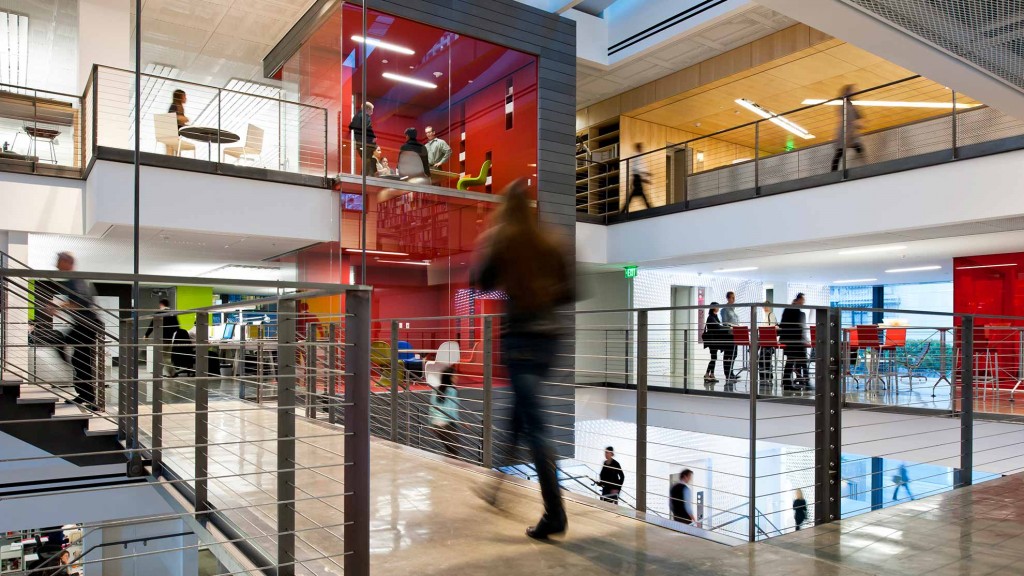What factors drive workplace performance?
The 2013 U.S. Workplace Survey
What We Did
Note: this report is part of an ongoing series of research on the workplace - view the latest U.S. Workplace Survey
We commissioned a nationwide survey of 2,035 professionals to take the pulse of the US workplace and understand what a high-performance workplace looks like for today’s knowledge worker. The study examines the design factors that create an effective workplace; how design can better support knowledge worker engagement, satisfaction, and performance; and the influence of the workplace on organizational culture. We retained The Futures Company to conduct the survey and Precision Consulting to do the statistical analysis.
Analysis of this data, when compared with our survey data from 2008, paints a picture of how a high-performing workplace today really works, and the profound and positive influence that the workplace can have on the employee experience. To understand how a workplace best aligns with drivers of business success and employee engagement, we mined our survey data to identify workers performing at the highest levels. From our sample, 24% were thriving—outperforming and out-innovating their peers. We took a closer look to understand why.
The Context
Gensler’s 2013 survey represents the most recent iteration of ongoing research on the workplace, which began in 2005 with Gensler’s first workplace survey. A survey in 2006 established the connections between workplace design, employee productivity, and business competitiveness. In 2008, our research gave a framework for understanding knowledge work through the lens of four “work modes”: focus, collaborate, learn, and socialize. The effectiveness and support of all four work modes connect to employee productivity and satisfaction that impact company performance.
The world in 2013 is a different place. Today, knowledge workers are faced with an ever-changing business climate in which they must balance a wider variety of communications and a faster pace of change, often while being asked to do more with less. The workplace must follow suit, providing settings and support for the broadening diversity of activities that are increasingly couched within the workday. More and more, we see the workplace not as the sole location for work, but as the vital connection among myriad locations in which work happens. From desks and meeting rooms to co-work spaces to airports and hotels, today’s knowledge work happens not just at the scale of people and offices, but also at the scale of buildings, cities, and ultimately the globe. At the opposite end of this spectrum, our research uncovered the importance of supporting the focus work mode as key to effective workplace design.
The Results
US workers are struggling to work effectively. Overall workplace performance has dropped 6% as measured by aggregate WPI (Workplace Performance Index) scores for Gensler’s 2008 and 2013 survey respondents. The decrease in the effectiveness of focus work as ranked by employees drove this decline. Results show focus as a key effectiveness driver—those who can focus are also more able to collaborate, learn, and socialize than those who cannot. Interestingly, this pairs with a shift in how employees are spending their time: Time spent collaborating has decreased by 20% since 2008, while time spent focusing has increased by 13%.
Effective workplaces balance focus and collaboration. While individual focus and collaborative work are often thought to be opposites, our research demonstrates that they function best as complements. For the 24% of respondents who report that their workplaces reflect their companies’ prioritizing both individual and collaborative work—what we call a “balanced workplace”—we see significant spikes in performance. Importantly, our findings show that balance is possible in both open office and private office environments.
Choice drives performance and innovation. Employees who are given a choice of when and where to work are higher performing, more satisfied, and see their companies as more innovative. Enabling choice with the right alignment of tools, policies, and spaces is an opportunity for companies to create a climate in which autonomous, engaged employees can make meaningful decisions to maximize their individual job performance.
What This Means
Provide effective focus space. Enabling employees to perform their jobs effectively begins with supporting the individual, focused work that represents the core of their days and a critical aspect of employee and team performance. Design factors that influence the ability to focus most significantly include the functionality of primary space, design look and feel of primary space, and effective noise management.
Collaborate without sacrificing focus. Layering in alternative spaces that support collaboration enables the connections that drive success in today’s knowledge economy. The proximity and availability of alternative workspaces, both in and out of the office, are key to providing for effective collaboration. The quality of in-office amenities is also important.
Drive innovation through choice. A balanced workplace provides a variety of settings that allow employees to personally align tasks and spaces for optimal performance. Enhance choice by aligning technology tools and organizational policies to support choice in when and where to work.
What’s Next?
One particular point has emerged from our research: In today’s world, gathering and analyzing diagnostic and contextual data on what drives performance at the employee and organizational level is no longer a luxury. It’s an imperative—one that when leveraged uncovers new opportunities for success, and when forgotten leads to myriad consequences. Identifying and proactively supporting the balance and choice that drive success is a chance to gain competitive advantage at a time when it’s more necessary than ever.
Learn More
Team
Janet Pogue, Andreas Andreou, Christine Barber, Erik Lucken, Tim Pittman, The Futures Company (research consultant), Precision Consulting (statistical consultant)
Year Completed
2013
Comments or ideas for further questions we should investigate?
